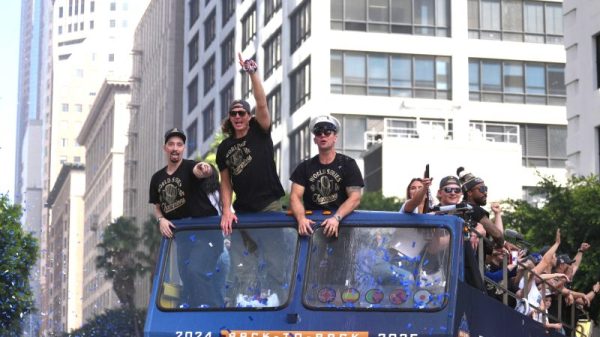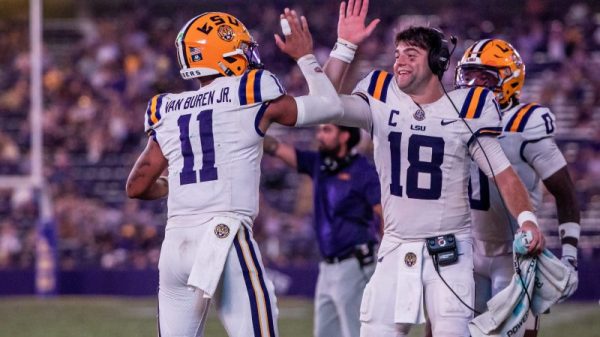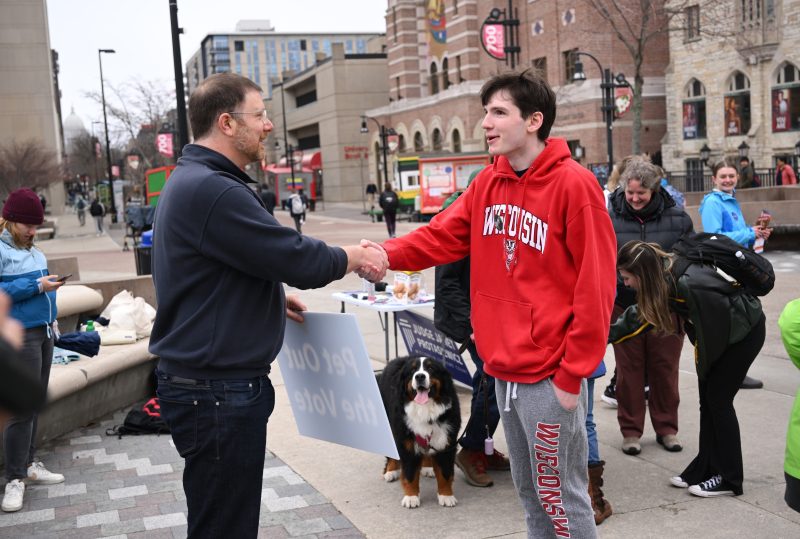MADISON, Wis. — When students at the University of Wisconsin at Madison entered one of the lecture halls in the George L. Mosse Humanities Building last Tuesday, they found small pieces of paper on the seats, one final reminder note in an elaborate organizing effort that produced a record turnout on campuses in a state Supreme Court election likely to end the state’s ban on abortion.
One side of the paper urged students to vote for liberal Milwaukee County Judge Janet Protasiewicz, the eventual victor against conservative former justice Daniel Kelly. But it was the other side that underscored the attention to detail and the lengths to which organizers had gone to assure the biggest campus turnout possible.
The back side read, “Where do I vote TODAY?” and broke down the polling places dormitory by dormitory, along with instructions on the kinds of identification to bring with them, and reminded them that they could register and vote at the same time. Similar instructions were distributed at other campuses across the state.
By day’s end, the results were beyond the expectations of the organizers here in Wisconsin, which has been one of the most closely divided states in the nation politically.
In Eau Claire, a city with 77 voting wards, the highest turnout was in Ward 20, which covered the upper campus of the University of Wisconsin at Eau Claire and residence halls. A total of 883 votes were cast and Protasiewicz got more than 87 percent of them, according to data provided to The Washington Post by Project 72 WI, a group focused on young voter turnout in the Supreme Court election and that supported Protasiewicz in the race.
Four years earlier, during another state Supreme Court election, turnout in the same ward had totaled 158 people. While overall turnout in the ward decreased from the 2022 midterms, Protasiewicz won a larger share of votes than Gov. Tony Evers (D).
In a number of University of Wisconsin precincts, turnout was near November’s midterms and Democrats were able to increase their vote share (the percentage of votes a candidate receives out of the total votes cast) from the 2022 gubernatorial race to this year’s Supreme Court election, contributing to Protasiewicz’s victory.
At the University of Wisconsin at Green Bay, which has a reputation as difficult to organize for Democratic campaigns, turnout was about three-quarters as much as it had been for the 2022 midterm election, according to Democratic organizers. Protasiewicz won about 85 percent of the vote.
In Madison, some campus wards turned out in higher percentages than some high-performing wards elsewhere in a city which has consistently had high turnout in recent general elections.
And this for an election that many college students did not even know existed a few months ago.
Eli Tsarovsky, 24, a graduate student and the president of the Campus Area Neighborhood Association in Madison, recalled seeing a moving truck with Protasiewicz’s face on it on campus — a physical embodiment of the outsize presence election organizers had at UW-Madison.
“I’ve not seen this since a presidential election. It’s just crazy, oh my goodness,” he said of the attention to the race on campus. “I’ve been listening to podcasts, watching YouTube and stuff, and I see this election [mentioned in ads] every single day. I get texts about it every single day.”
Protasiewicz won the Supreme Court election by 11 percentage points and likely would have prevailed even without the kind of support she received from college students. The focus on the campuses was part of an overall effort that included broader get-out-the-vote activities by the state party and a huge investment in advertising. But her margins in campus areas exceeded those statewide.
The performance on the campuses was an indication that past assumptions about young voters may be becoming obsolete and that when young voters are engaged and mobilized, they can turn out in significant numbers.
“The students in college today came of age in the 2016 election, when people didn’t vote and we got Trumpism,” said Teddy Landis, the director of Project 72 WI, the organizing unit focused on the campuses. “They’ve been hearing this is the most important election of their lives every single election [since 2016], and it’s true. So when we go to them, they say, ‘Of course’ [they’ll vote].”
Ben Wikler, 42, the Democratic Party chair in Wisconsin, said the state party has been running a continuous program of youth organizing since he was elected in 2019, one that has been ramping up steadily. For the Supreme Court election, there was special focus on the campus vote.
Mike Tate, 44, a former state Democratic Party chair who had begun his political career organizing on the Madison campus for Al Gore, played point initially. Believing that more effort was needed to mobilize college students, he was able to obtain seed money for the student-focused project and set out to build a team under what became known as Project 72 WI, the 72 referring to the number of counties in the state.
To run the program, Tate recruited Landis, 25, who had previously been an organizer for the Wisconsin state party. Landis then helped recruit three others to join: Brianna Koerth, 25; Alex Teodorescu, 23; and Julia Alexander 23. Koerth and Teodorescu also had worked previously for the state party, while Alexander had run youth organizing for Democrats in Arizona during the 2022 election.
Landis described them as the “Avengers of youth vote.” Tate called them “the dream team and the old man.”
Project 72 WI eventually assembled a paid staff of more than 100 people, with organizers on 15 college campuses in the state. By the time the election was over, they had spent close to $1 million on campus-focused activities, a relatively small sum given the amount of money spent by both sides on the election. “If you invest in young voters, the returns are incredible,” Landis said.
Abortion also proved to be a powerful motivator, to no one’s surprise. Protasiewicz and the Democrats supporting her focused relentlessly on abortion rights after the U.S. Supreme Court overturned Roe v. Wade, the 1973 decision that guaranteed a right to abortion.
“The incredibly personal threat posed by the Wisconsin abortion ban…meant that in an election that normally has almost no resonance among young people, in this election, campus wards were packed,” Wikler said. But more broadly, the issues of democracy and personal freedoms also brought students out in big numbers.
“This generation of young people are primed to participate in the electoral process,” Tate said. “They simply need to know how to do it.”
Tate is quick to give credit to others beyond Project 72 WI, noting how much groups around the country had done to focus attention on the court election and mobilize voters.
“It’s not that the university isn’t doing their job, but they’re pretty heavily underfunded when it comes to, like, voting, or the program just isn’t large enough,” said Jason Rivera, 22, a senior at UW-Madison who works with Rise, one of the other organizations involved in the engagement effort.
But it was the team headed by Landis that took the lead, with Tate as a senior adviser. “My job was to marshal this tremendous amount of talent,” Tate said. “To hear the good ideas and say, ‘How can you scale that by a hundred?’ and we’ll get the resources to get it done.”
Project 72 WI set up tables on campuses with bright red tablecloths with “Wisconsin State Supreme Court” in bold white letters. The tables were in prominent places, outside when the weather was above 35 degrees, inside when it wasn’t. “Organizers have been out there every single day, whether raining or snowing or hailing,” Landis said. “Talking about what is the Wisconsin Supreme Court, what are the issues at stake, and why would your vote make such a difference in this.”
They asked students first to pledge to vote, then to make a plan for voting. As Election Day neared, Landis said, “If you yelled out, ‘Do you have a plan to vote next week?’ almost every single person said, ‘Yes.’” And if asked where, he said, students responded with the location of their polling place.
The organizers canvassed campus bars. They took Polaroid photos with the label “Hot Girls Vote.” They had people in judicial robes to attract attention. “We probably bought every single judge costume in Amazon stock,” Landis said.
They sought to maximize social networks. “Every bit of social media we did was designed to have students share it on their own networks,” Tate said. “It’s exponentially more valuable than something from a campaign.” One photo of a line of students waiting to vote in Eau Claire on Tuesday drew 2 million views.
Landis said that organizers knocked on 40,000 doors — in residence halls and student apartment buildings. Ahead of the election, they put up 500 yard signs in the shape of gavels on Bascom Hill at the UW-Madison campus with “Vote Early” in gigantic letters. Days after the election, Landis was trying to figure out what to do with those gavels.
The morning of the election, they blanketed classrooms with the quarter-sheets listing how and where to vote. Those cards were one contribution from Tate, who had developed the idea back when he was a college organizer for Gore. “We probably handed out 50,000 across the state,” Landis said.
For young people in Madison, the investment in youth-focused voter outreach is welcome.
“One thing I see often is that people just take advantage of the youth vote, like they assume like, oh, you’re under the age of 25. You’re gonna vote this way,” said Juliana Bennett, 23, who serves as an alder representing part of the UW-Madison campus.
“All too often, there’s energies focused towards changing the minds of someone that is going to vote rather than reaching out to a population that probably would vote — and would vote for you — if you just reached out to them.”



























